#ES64F4
Explore tagged Tumblr posts
Text


( 🚂 )
#stim#visual stim#stim gifset#mine#train#fret train#shunting#shunter 601#ES64F4#br189#locomotive#red#orange#yellow#no hands#vehicle
25 notes
·
View notes
Text
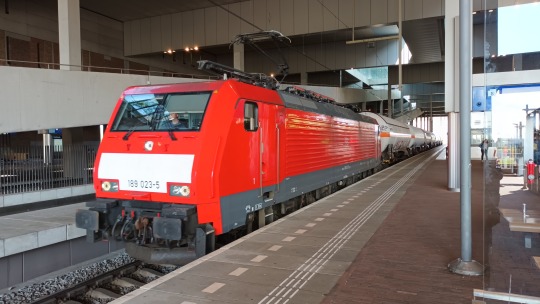
DB ES64F4 189023 at Breda train station
1 note
·
View note
Text
When it rains, it pours, or something like that. Model trains are usually produced in small series, so if you want a particular locomotive, you best pre-order it months, sometimes years in advance, and that can mean sometimes two locomotives arrive on the same day. Like yesterday.
First, from my local dealer, I got the DB class 152 from Piko.
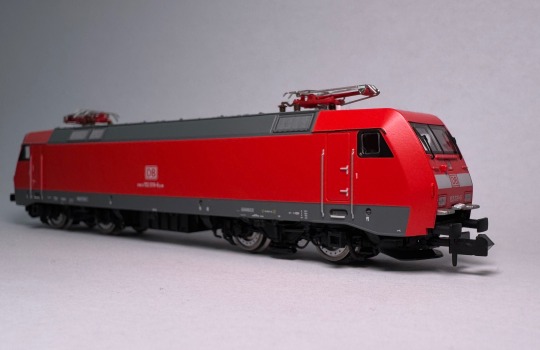

The class 152, or Siemens ES64F as it's called by its manufacturer (no number after the F, the ES64F4 is a related but different locomotive) is a heavy freight locomotive that was built in the late 1990s and very early 2000s. 6.4 MW power (that's about 8600 horsepower) are quite an impressive figure. That said, its role in the German locomotive history is not particularly remarkable. It was part of the transition from locomotives designed by individual builders (instead of by the railway, and then jointly built by all the different manufacturers together), and it was part of the transition from one integrated railroads to various sectors, which is why it's a heavy freight locomotive, as opposed to a heavy universal locomotive, in the first place. A universal freight and high-speed passenger derivative of this design exists in huge numbers in Austria, as the Taurus family.
In the end the 152 was overtaken by newer developments. DB originally planned to order 195 with options for a further 100. But first the final 25 were transferred into Austrian style Taurus locomotives, because the 152 wasn't approved for Austria (DB cheaped out and ordered bogies that, it turned out, produce more annoying forces than legal in Austria). And the final 100 were turned into the class 189 (that's the Siemens ES64F4), a multi-system version that can run in many different European countries.
A similar story exists with private companies: Technically the 152 was at the forefront, because Siemens produced two more and put them into Dispolok, at the time their in-house leasing company (since sold several times over). But most of Dispolok's fleet ended up being the Taurus and ES64F4 and since then the Vectron, successor to both of them, and the 152 remained a side note. They are nowadays sold to ITL, part of Captrain.
However, the 152 has a very important part in my personal history. Back in January of 2008, I took a couple of picture of one in Aachen West, the station near my university.
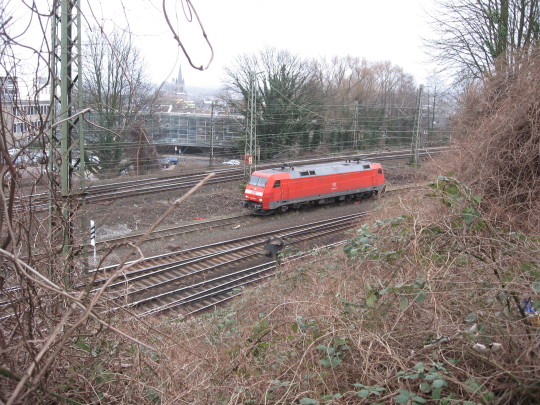

And then some time later, I don't recall when (the earliest files I can find seem to have been created mid-2012, which feels right), I used this as the basis for a user icon that I've since used, in various forms… everywhere. If you see it somewhere, that's me, unless the person using it is saying nonsense, in which case it's an impersonator.
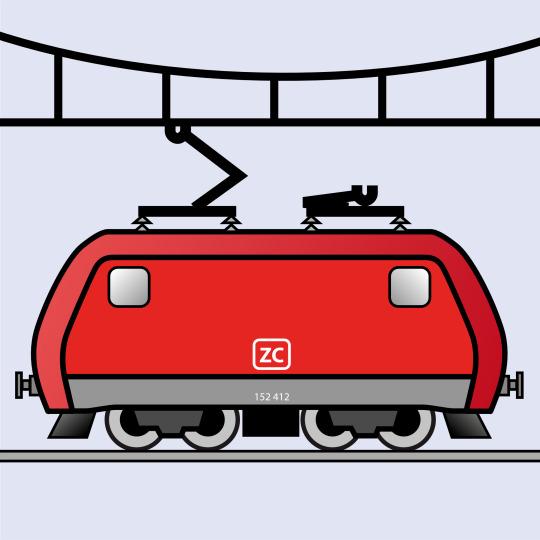
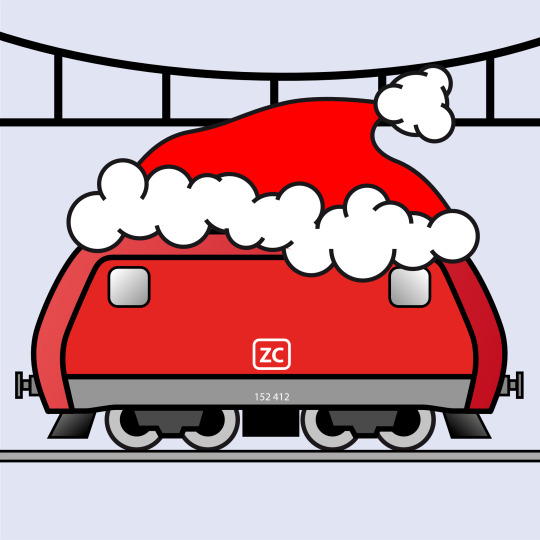
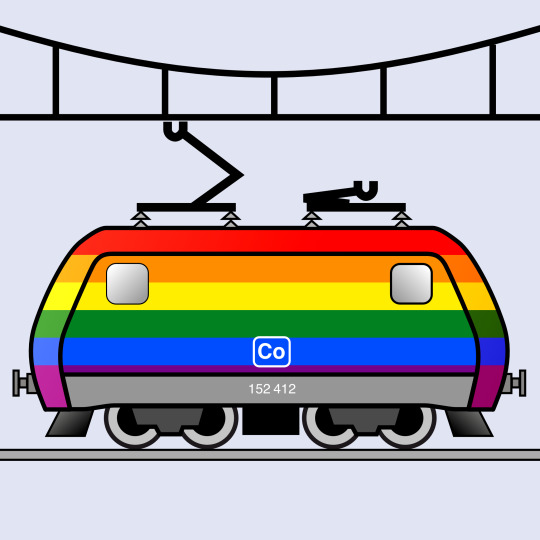

So, yeah, no choice, I just had to buy it.
The model is from Piko and I've equipped it with an ESU LokPilot 5 micro DCC decoder (with Next18 interface). It all looks and works fine, my main tip would be to actually read the instructions. That way you'll learn that the body is screwed instead of clipped on, with screws hidden underneath the trucks, and also that you need to enable SUSI on the decoder, because the light functions are controlled not by the decoder but a chip in the locomotive.
(To put it simply, there's a tiny computer network inside the tiny locomotive.)

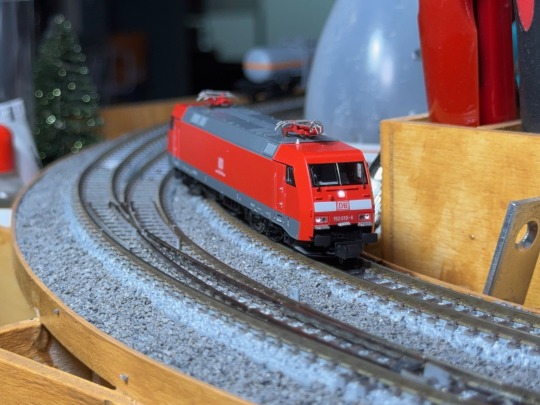


As you can see, there's normal front light, rear light (separately controlled), interior cab light and high-beam headlights. The 152, like most modern locomotives, has the outer lights for normal headlights and tail lights, with the inner lights specifically used as additional high-beams, which is implemented perfectly here. Oh, and it also runs without issue.
But it doesn't end there, because while I was getting ready to go to the model train store (where I'd actually just been earlier, to get something else; I saw the email that the locomotive was ready about ten minutes after I left), I also got an email that I got a package with a different pre-ordered locomotive.
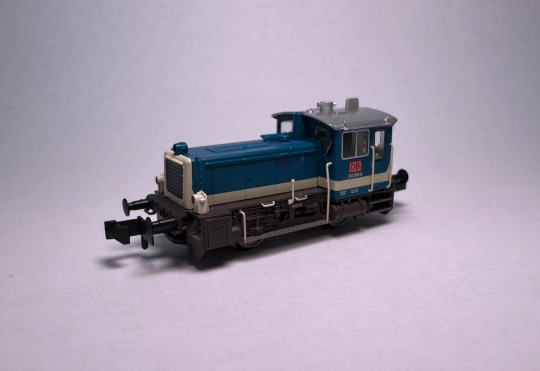

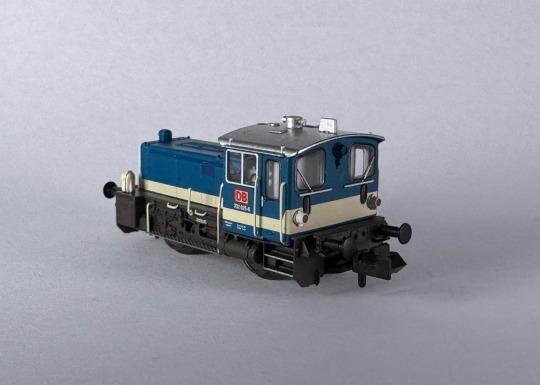
This is a class 332, also known as Köf III (as in 3). The Köf III family also includes a number of other class numbers, but the locomotive is functionally and visually the same.
It's a small west-german shunter, built in the 1960s. The "Köf" designator means it was classified as a "Kleinlok", "Small locomotive", which meant a small shunter for use within station limits only that crucially did not need a fully trained engineer. The öf stands for oil burning and fluid drive, i.e. diesel motor with a hydraulic torque converter, and the III means power category three, in practice 240 horsepower. Despite the designation, some of them have also been equipped for very local road service on lines where its 45 km/h (30 mph) top speed is enough. Others have been relegated to be used as shop machines, being officially downgraded from "locomotive" to "tool" or "device", which, again, means you need an even less fully trained engineer. Some also came back from "device" status to "locomotive" status. These have since been sold all over both as shunters and for construction trains, with some ending up in various countries in Africa or even Thailand, supposedly.
The model is by Liliput, nowadays the German and Austrian division of Bachmann, and besides being small and adorable, it has a particular party trick: Remote controlled coupling and uncoupling.
Using the built-in DCC decoder, you can uncouple anywhere on the layout. It even does a little dance, first pushing closer to the car, then opening the coupler, then automatically driving away. It can also open the coupler so it can couple more easily to stationary cars, instead of pushing them away, which happens frequently with the normal N scale coupler. This last feature requires some tight timing, though, I don't yet fully get it right all the time.
The locomotive doesn't run perfectly, it doesn't seem to have any buffer capacitors and is very picky about the cleanliness of the rails. I think some running in should help here, though.
These locomotives have been a long time coming. They were originally announced for 2020, but severely delayed. I pre-ordered mine in October of 2022, already long after they were supposed to be out, but it still took until now for them to finally ship.
Thankfully, pre-ordering meant I only had to pay 2022 pre-order prices instead of the ones I'd have to pay now. I saved about 30€ that way. What to spend them on, though? Ah, I know! A second one of them!



Yeah, on my way to picking up the package, I passed through the local fake Lego store that we have for some reason, and they had that very locomotive. How could I not buy it?
(Okay, both the actual Lego Company and Bluebrixx, the company that runs the store and made this kit, will probably be angry with me for calling this "fake Lego" instead of, like, "compatible plastic building bricks" or "Klemmbausteine" or whatever. And in a legal sense, yes, this is absolutely not Lego, it's just compatible with it, and it's 100% Lego and not claiming to be Lego, so it's legally clearly not fake either… but let's be real. Neither company is paying me. This is fake Lego.)
The quality of that kit is typical Bluebrixx, which is to say, you don't pay a lot, and you get what you pay for. A few pieces don't quite have the same shade of grey as the ones around them, and the design is in parts cool, in parts needlessly complicated, frustrating and unstable. The instructions, which don't come in the box, you have to download them, aren't always fully clear either. It's objectively worse than real Lego, but not so much that you should dismiss it out of hand, I guess. Besides, real Lego make exactly one train every five years, so buying from them is sadly literally not an option.
Anyway, between that and the ASF, that's been quite a lot. I love these locomotives, but, you know, I still need to pay money for food and stuff eventually.
15 notes
·
View notes
Video
ES 64 F4-101 by maurizio messa Via Flickr: 189 101 - Himmelstadt - 07.05.2016
#Bayern#KV#kombinierter#SIEMENS#ES64F4#EuroSprinter#MRCE#BR189#Intermodale#NIKOND7100#Cargo#mau#Bahn#Ferrovia#freight train#FRET#guterzuge#Germania#Germany#Treni#Trains#railway#Railroad
4 notes
·
View notes
Photo
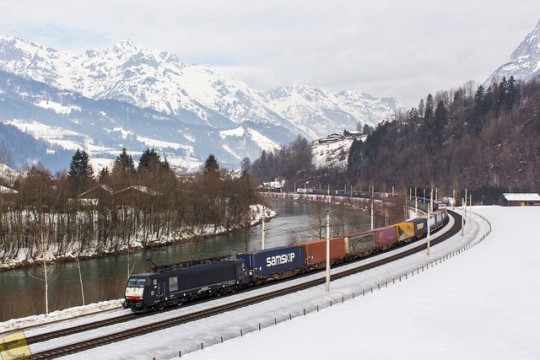
An average container train hauled by the Siemens ES64F4-009 right after Pfarrwerfen, Austria.
21.02.2019
10 notes
·
View notes
Photo
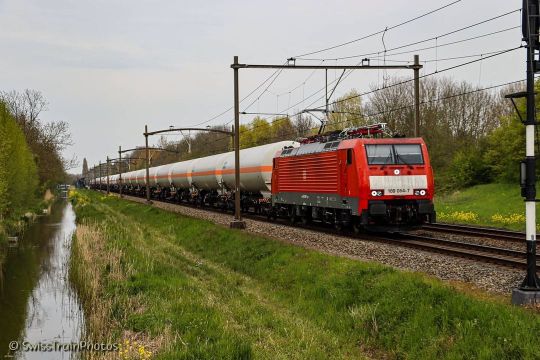
⬇️ ÖFFNE DIE BESCHREIBUNG ⬇️ ▪️▪️▪️▪️▪️▪️ ▫️ ▫️ Nach eine lange zeit gewartet zu haben auf dieser zug kam hier ein Gas-Kesselzug von DB Cargo durch der fotostelle in Dordrecht-Süd ▫️ ▫️ ▪️▪️▪️▪️▪️▪️ 🚂 Siemens ES 64 F4 🛤 Dordrecht-Süd, ZH 📆 28-04-2021 📸 Canon EOS 250D 🎛 Adobe Lightroom 👥 Mit Dabei war -> @trainlovenl ▪️▪️▪️▪️▪️▪️ 🇩🇪 ➖➖ DeutscheBahn Cargo ➖➖ 🇩🇪 ▪️▪️▪️▪️▪️▪️ ⬇️ PARTNERSEITEN ⬇️ 🔻 Bitte folgt Aller hier Unten 🔻 @erichgillard @sbb_trains @zugwelt_schweiz @trainspotterhuttu @railwayphotos_tiziano @trainspotter_burgdorf @swisstrainspotting @swisstransportation @photostrainssuisse @trainspotter_seeland @trainspotter_by_sam @tp.spotter @gotthard.nordrampe @swiss_trainspics @eisenbahnbilder_de @trainspotting_spreewald @oepnv.ch @trainspotter_schluchsee ▪️▪️▪️▪️▪️▪️ ▫️ ▫️ ▪️▪️▪️▪️▪️▪️▪️▪️▪️▪️▪️ ⬇️ Hashtags ⬇️ #trainspotting #trainspotter #DeutscheBahn #DB #DBCargo #ES64F4 #bahnbilder #railway #Holland #eisenbahnromantik #eisenbahn #eisenbahnfotografie #trainpictures #trains #trainspottingpictures #picturesoftrains #trainstagram #railstagram #trainphoto #trainsofinstagram #züge #Dutchtrains #DutchTrainPhotos #Dutch #Rail #Netherlands #Trainpics #railways_of_our_world #railways_worldwide #WorldwideRailways ▪️▪️▪️▪️▪️▪️▪️▪️▪️▪️▪️ (hier: Dordrecht) https://www.instagram.com/p/COl409gnfAm/?igshid=1oengvi0bef35
#trainspotting#trainspotter#deutschebahn#db#dbcargo#es64f4#bahnbilder#railway#holland#eisenbahnromantik#eisenbahn#eisenbahnfotografie#trainpictures#trains#trainspottingpictures#picturesoftrains#trainstagram#railstagram#trainphoto#trainsofinstagram#züge#dutchtrains#dutchtrainphotos#dutch#rail#netherlands#trainpics#railways_of_our_world#railways_worldwide#worldwiderailways
0 notes
Video
ES64F4 104 by Kevin Biétry Via Flickr: Une locomotive de MRCE Dispolok en gare de Basel SBB.
1 note
·
View note
Photo



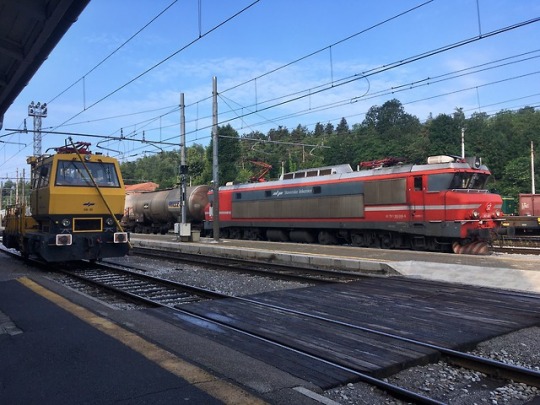

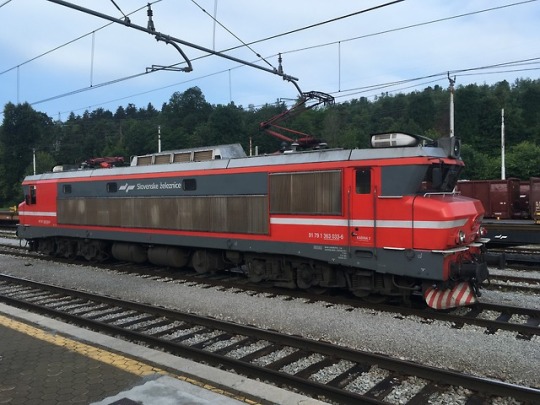
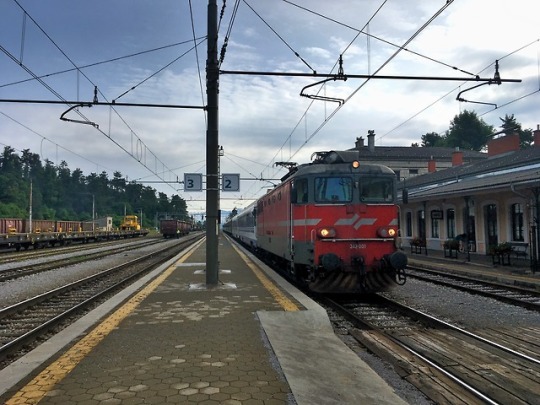

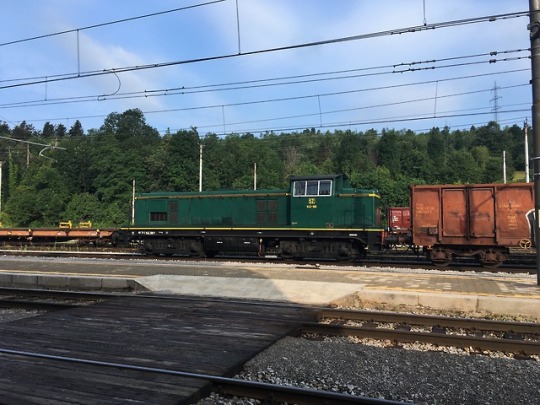
Mercredi 4 juillet : Pivka
Après le mardi passé à Venise (je passe sur l’arrivée du Thello avec + 210 environ !), le mercredi direction Rijeka en Croatie. Pour cela, je m’étais déjà rapproché la veille de la frontière italo-slovène en dormant à Trieste.
Le mercredi matin donc, je prends un bus très tôt le matin pour aller en gare de Villa Opicina, Il y avait avant un tram historique qui faisait la liaison mais cela fait des années qu’il ne roule plus... Bref, arrivé à la gare frontière, je monte dans un Desiro électrique (série SŽ 312) que je vais emprunter jusqu’à Pivka, une bifurcation majeure du réseau slovène puisqu’elle permet la liaison : avec Ljubljana au nord, Sežana à l’ouest (et toutes ses ramifications, Pula, Trieste, Koper, et la ligne de Jesenice), et Ilirska Bistrica/Rijeka au sud.
Par chance, l’Opatija, nom du train qui doit m’emmener en Croatie, avait une vingtaine de minutes de retard, ce qui m’a permis de spotter quelques circulations en gare, et il n’y avait pas de quoi s’ennuyer, même sur cette voie unique ! Entre les manoeuvres dans le triage avec la 642 (quasi-identique à nos BB 63500), le passage de frets comme celui encadré par une ES64F4 et une ER20, les quelques matériels de l’Infra locale, et, le clou du spectacle... une Brigitte, y avait de quoi faire !
Puis enfin, le train 481, baptisé Opatija, du nom de la station balnéaire située juste avant Rijeka et desservie par ce train, arrive en gare, tracté par une locomotive de la série 342, une BB ex-Yougoslave capable d’atteindre 120 km/h. À noter la très belle composition à 8 voitures : d’abord deux voitures croates directes de l’EN 499 Lisinksi en provenance de Münich, trois voitures slovènes de Ljubljana, puis trois voitures hongroises directes du MV 1246 Istria depuis Budapest, le même que je vais prendre le soir pour rejoindre cette capitale. Un joli train multi-tranches donc comme il n’en existe plus en France !
0 notes
Photo

LTE keteltrein naar Kralupy
0 notes
Text


( 🚂 )
#stim#visual stim#stim gifset#mine#train#fret train#es64f4#br189#red#orange#yellow#no hands#vehicle#grey#locomotive#shunting#shunter 601
12 notes
·
View notes
Text
I'm starting to warm up to Train Sim World 3, a game I got via Microsoft's game subscription model. A huge part of that is because it has a lot of good tutorials for all the very non-obvious parts of it. Those non-obvious parts are there for realism, to be clear; most trains aren't designed to be obvious, they're designed to be run by trained personnel who got special training for all the details of each train they're on.
Anyway, the basic tutorials are all set in a fantasy location, the Training Center. It's a magic place where you will find German, British and American trains all next to each other on decidedly German infrastructure.

The setting is all over the place, with some alpine stuff, a lake, several station platforms, and the whole thing is notably not an A-to-B line. Instead it's a combination of different loops and sidings for shunting around that feels more like a model railroad than a real thing.

Clearly this is completely made up, right?
Well, no. While all the scenery is purely fantasy and quite a bit of the details are wrong, the track layout is in fact a real piece of railroad infrastructure. Specifically, this is the track layout of the Siemens Test Centre in Wegberg-Wildenrath, Germany, near… well, not really anything, but Mönchengladbach is the closest city.
This facility, built on the site of a former British airfield, is where Siemens (and to a small extent other manufacturers) tests new trains, both prototypes and sometimes individual ones. All the tracks are for testing trains at different speeds and in different conditions, and a lot also for storing trains. There are also big workshops, used for finishing touches, indoor tests, but also as an independent repair and maintenance facility, and to assemble trains built in other places.
According to its own description, it's the most modern of such test centres. I have no way of checking that. It is definitely not the biggest, that is VUZ in Velim in the Czech Republic, which has a much bigger outer loop allowing for higher speeds, but less other equipment and tracks as far as satellite images say. VUZ is still seeing a lot of use, though. Maybe they'll use that one as the training centre for Train Sim World 4.
Access to the Wegberg facility is difficult for rail fans. It isn't hidden by any means, it's about an hour's drive from where I live, but all the really fun parts are hidden behind gates and fences, and security patrols the area. They held I think like two open days for the public, in total, and the last one as far as I can tell was in 2012.
And of course I was there.


Hey, remember those days when the Vectron was fresh and new, and Siemens was still actively selling the class 189 (ES64F4) and that in-between generation they only ever sold to Portugal, Belgium and Lithuania? That sure was a while ago, now they've sold well over a thousand Vectrons and those beasts are everywhere.
First big difference between video game and reality: In reality, the outer loop is only single track, while the video game has it double-tracked.

The video game also gives me a top speed of 300 km/h for this outer loop. In reality, as far as I know the limit ist 160 km/h. Apparently the track gets checked and realigned weekly, to be sure that the measurement results are all accurate.
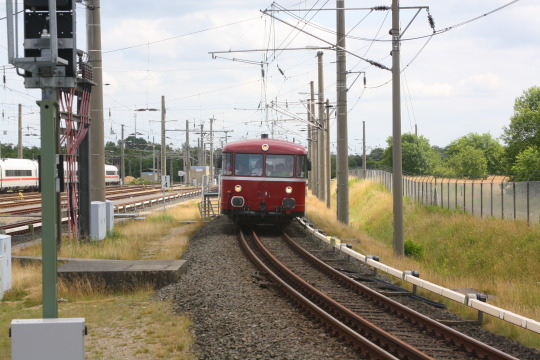
Yes, that is an Uerdinger Schienenbus. Yes, that did retroactively become a Siemens product, because the Uerdinger Waggonfabrik that built this dinky little rail bus ended up becoming Siemens's Krefeld plant (specifically the Uerdingen part of Krefeld, no longer an independent town), where they build all their high speed trains among others. Surprised the hell out of me too.
In the game, all lines are electrified and have British style third rail power. In reality, that is actually fairly close. Many tracks are not electrified, though (they have diesel shunters to deal with that, including some hilariously old ones). Even fewer have the British style third rail, although that is in use because Siemens does sell a lot of trains to Britain. Instead, some tracks, such as the inner loop, feature Berlin style third rail, raised, with a plastic cover and designed for bottom contact.
And in fact there's a fourth rail here, which the video game doesn't have. This is to test meter gauge trains; generally speaking that means trams. However, for the opening ceremony 25 years ago, they apparently did have a steam train from nearby historic steam railroad Selfkantbahn. Definitely the second-greatest historic steam railroad around Aachen.
Anyway, the point of this is… none whatsoever. I just thought it's funny. The makers of the game aren't hiding that they just took the Wildenberg-Wegrath track layout, you can find a number of news articles referencing this. But if you just downloaded the game because you got Game Pass and it says "train something", as you do, then you may never notice unless you're already aware of this test centre.
7 notes
·
View notes
